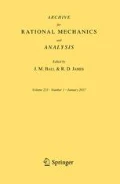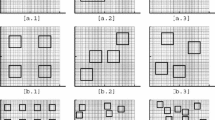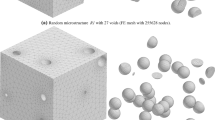Abstract
This work is concerned with the derivation of optimal scaling laws, in the sense of matching lower and upper bounds on the energy, for a solid undergoing ductile fracture. The specific problem considered concerns a material sample in the form of an infinite slab of finite thickness subjected to prescribed opening displacements on its two surfaces. The solid is assumed to obey deformation-theory of plasticity and, in order to further simplify the analysis, we assume isotropic rigid-plastic deformations with zero plastic spin. When hardening exponents are given values consistent with observation, the energy is found to exhibit sublinear growth. We regularize the energy through the addition of nonlocal energy terms of the strain-gradient plasticity type. This nonlocal regularization has the effect of introducing an intrinsic length scale into the energy. Under these assumptions, ductile fracture emerges as the net result of two competing effects: whereas the sublinear growth of the local energy promotes localization of deformation to failure planes, the nonlocal regularization stabilizes this process, thus resulting in an orderly progression towards failure and a well-defined specific fracture energy. The optimal scaling laws derived here show that ductile fracture results from localization of deformations to void sheets, and that it requires a well-defined energy per unit fracture area. In particular, fractal modes of fracture are ruled out under the assumptions of the analysis. The optimal scaling laws additionally show that ductile fracture is cohesive in nature, that is, it obeys a well-defined relation between tractions and opening displacements. Finally, the scaling laws supply a link between micromechanical properties and macroscopic fracture properties. In particular, they reveal the relative roles that surface energy and microplasticity play as contributors to the specific fracture energy of the material.
Similar content being viewed by others
References
Aubry S., Ortiz M. (2003) The mechanics of deformation-induced subgrain-dislocation structures in metallic crystals at large strains. Proc. R. Soc. Lond. A 459: 3131–3158
Bai Y., Dodd B. (1992) Adiabatic Shear Localization: Occurrence, Theories, and Applications, 1st edn. Pergamon Press, Oxford
Ball J.M. (1982) Discontinuous equilibrium solutions and cavitation in nonlinear elasticity. Philos. Trans. R. Soc. Lond. Ser. A 306(1496): 557–611
Bassani J.L. (2001) Incompatibility and a simple gradient theory of plasticity. J. Mech. Phys. Solids 49(9): 1983–1996
Choksi R., Kohn R.V., Otto F. (1999) Domain branching in uniaxial ferromagnets: a scaling law for the minimum energy. Commun. Math. Phys. 201: 61–79
Considère A. (1885) Mémoire sur lemploi du fer et de lacier dans les constructions. Annales des Ponts et Chaussées 9: 574–775
Conti S. (2000) Branched microstructures: scaling and asymptotic self-similarity. Commun. Pure Appl. Math. 53: 1448–1474
Conti S., DeLellis C. (2003) Some remarks on the theory of elasticity for compressible neohookean materials. Ann. Scuola Norm. Sup. Pisa Cl. Sci. 5(2): 521–549
Conti S., Garroni A., Müller S. (2011) Singular kernels, multiscale decomposition of microstructure, and dislocation models. Arch. Rational Mech. Anal. 199(3): 779–819
Conti S., Ortiz M. (2005) Dislocation microstructures and the effective behavior of single crystals. Arch. Rational Mech. Anal. 176: 103–147
Fleck N.A., Hutchinson J.W. (1993) A phenomenological theory for strain gradient effects in plasticity. J. Mech. Phys. Solids 41(12): 1825–1857
Fleck N.A., Hutchinson J.W. (1997) Strain gradient plasticity. Adv. Appl. Mech. 33: 295–361
Fleck N.A., Hutchinson J.W. (2001) A reformulation of strain gradient plasticity. J. Mech. Phys. Solids 49(10): 2245–2271
Fleck N.A., Muller G.M., Ashby M.F., Hutchinson J.W. (1994) Strain gradient plasticity—theory and experiment. Acta Metallurgica Et Materialia 42(2): 475–487
Garrison W.M., Moody N.R. (1987) Ductile fracture. J. Phys. Chem. Solids 48: 1035–1074
Garroni A., Leoni G., Ponsiglione M. (2010) Gradient theory for plasticity via homogenization of discrete dislocations. J. Eur. Math. Soc. 12(5): 1231–1266
Garroni A., Müller S. (2005) Gamma-limit of a phase-field model of dislocations. SIAM J. Math. Anal. 36(6): 1943–1964
Garroni A., Müller S. (2006) A variational model for dislocations in the line tension limit. Arch. Rational Mech. Anal. 181(3): 535–578
Heller, A.: How metals fail. Science & Technology Review Magazine, Lawrence Livermore National Laboratory pp. 13–20, 2002
Henao D., Mora-Corral C. (2010) Invertibility and weak continuity of the determinant for the modelling of cavitation and fracture in nonlinear elasticity. Arch. Rational Mech. Anal. 197: 619–655
Huang Y., Xue Z., Gao H., Nix W.D., Xia Z.C. (2000) A study of microindentation hardness tests by mechanism-based strain gradient plasticity. J. Mater. Res. 15(8): 1786–1796
Kanninen M.F., Popelar C.H. (1985) Advanced fracture mechanics. Oxford Engineering Science Series. Oxford University Press, New York
Kohn R.V., Müller S. (1992) Branching of twins near an austenite-twinned-martensite interface. Phil. Mag. A 66: 697–715
Kohn R.V., Müller S. (1994) Surface energy and microstructure in coherent phase transitions. Commun. Pure Appl. Math. 47: 405–435
Kröner, E.: Mechanics of generalized continua. In: Proceedings of the IUTAM-symposium on the Generalized Cosserat Continuum and the Continuum Theory of Dislocations with Applications, Freudenstadt and Stuttgart (Germany) 1967. Springer, Berlin, 1968
Kuroda M., Tvergaard V. (2008) A finite deformation theory of higher-order gradient crystal plasticity. J. Mech. Phys. Solids 56(8): 2573–2584
Kuroda M., Tvergaard V. (2008) On the formulations of higher-order strain gradient crystal plasticity models. J. Mech. Phys. Solids 56(4): 1591–1608
Kuroda M., Tvergaard V. (2010) An alternative treatment of phenomenological higher-order strain-gradient plasticity theory. Int. J. Plast. 26(4): 507–515
Lubliner J. (1990) Plasticity Theory. Macmillan, New York
Martin J.B. (1975) Plasticity: fundamentals and general results. MIT Press, Cambridge
McClintock, F.A., Argon, A.S.: Mechanical behavior of materials. In: Addison-Wesley Series in Metallurgy and Materials. Addison-Wesley, Reading, 1966
Mielke A., Ortiz M. (2008) A class of minimum principles for characterizing the trajectories and the relaxation of dissipative systems. ESAIM Control Optim. Calc. Var. 14(3): 494–516
Müller S., Spector S.J. (1995) An existence theory for nonlinear elasticity that allows for cavitation. Arch. Rational Mech. Anal. 131: 1–66
Needleman A., Tvergaard V., Bouchaud E. (2012) Prediction of ductile fracture surface roughness scaling. J. Appl. Mech. Trans. ASME 79: 3
Nix W.D., Gao H.J. (1998) Indentation size effects in crystalline materials: a law for strain gradient plasticity. J. Mech. Phys. Solids 46(3): 411–425
Ortiz M., Repetto E. (1999) Nonconvex energy minimization and dislocation structures in ductile single crystals. J. Mech. Phys. Solids 47(2): 397–462
Ortiz M., Repetto E., Stainier L. (2000) A theory of subgrain dislocation structures. J. Mech. Phys. Solids 48: 2077–2114
Pardoen T., Hutchinson J.W. (2003) Micromechanics-based model for trends in toughness of ductile metals. Acta Mater. 51(1): 133–148
Rice J.R., Thomson R. (1974) Ductile versus brittle behavior of crystals. Philos. Mag. 29(1): 73–97
Sverák V. (1988) Regularity properties of deformations with finite energy. Arch. Rational Mech. Anal. 100: 105–127
Tvergaard V. (1982) Ductile fracture by cavity nucleation between larger voids. J. Mech. Phys. Solids 30(4): 265–286
Tvergaard V. (1990) Material failure by void growth to coalescence. Adv. Appl. Mech. 27: 83–151
Tvergaard V. (1992) A numerical-analysis of 3d localization failure by a void-sheet mechanism. Eng. Fract. Mech. 41(6): 787–803
Xue Z., Huang Y., Gao F., Nix W.D. (2000) The strain gradient effects in micro-indentation hardness experiments. Multisc. Phenom. Mater. Exp. Model. 578: 53–58
Author information
Authors and Affiliations
Corresponding author
Additional information
Communicated by The Editors
Rights and permissions
About this article
Cite this article
Fokoua, L., Conti, S. & Ortiz, M. Optimal Scaling in Solids Undergoing Ductile Fracture by Void Sheet Formation. Arch Rational Mech Anal 212, 331–357 (2014). https://doi.org/10.1007/s00205-013-0687-8
Received:
Accepted:
Published:
Issue Date:
DOI: https://doi.org/10.1007/s00205-013-0687-8




